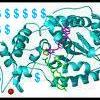On december 29, 2007 a new study was published:
http://www.ncbi.nlm....Pubmed_RVDocSum
This finding may change everything about resveratrol theories. The importance is that MnSOD was 6 times more plentiful and 14 times more active. This greatly reduces cellular oxidation and increases efficiency at the core of respiration so it has a strong connection to calorie restriction independent of SIRT1. Possibly SIRT1 changes because of the MnSOD change. MnSOD is at a deeper, more fundamental level of respiration (aka aging) than SIRT1.
14 times more Active???
Any chemical reaction in the body that suddenly occurs 14 times more often should be so unnatural that it kills you. However, we already know it almost doubles lifespan in 5 wildly different species and has no relevant toxicity in any animal. If you're interested in how resveratrol works, the importance of what reservatrol does to MnSOD cannot be underestimated.
Importance of increasing MnSOD: In order to make ATP (cellular energy) there are three pumps in the membrane of mitochondria that use the energy from the chemicals from the krebs cycle to pump H+ to an outer-mitochondria area. A superoxide oxidation radical is formed in the process which is deactivated by MnSOD to less reactive peroxide H2O2. That provides a whopper of an antioxidant effect. But it also increases respiration effificiency because those H+ ions need to gather up on the outside before being pushed back into the inner mitochondria to create ATP. Remember, like charges like H+ repel each other. But those superoxide radicals are negatively charged and are attracted to the H+ and cross the membrane. Without the MnSOD, more H+ may get neutralized by the superoxides and not be allowed to create ATP energy. Superoxides outside the membrane will decrease the electrical push needed to get the H+ back inside to create ATP. Increased efficiency in the process means fewer calories are burned for the same amount of energy. Normally there is something like a 4% "leakage" of superoxides from respiration, but the hyperactive MnSOD may stop it.
Cancer: Many cancers are the result of MnSOD being altered on chromosone 6 or p53 being altered. p53 increases MnSOD to fight cancer. I believe a bad MnSOD/superoxide ratio in the presence of higher catalase allows cancer to use oxidation to breakapart collagen and spread quickly. Altering the MnSOD or p53 genes is a common way that cancer does this. They can give MnSOD to kill cancer cells, so why not increase increase it's activity by a factor of FOURTEEN. Everyone with cancer should be taking 1 to 4 g/day RESV and 2 to 4 g/day Quercetin.
The big picture
MnSOD, resveratrol, exercise, and calorie restriction all 4 reduce cancer, lower blood sugar, and increase life span. This is because they improve the energy liberation process of respiration. That is, they improve life itself, at the core.
Toxicity
I read many posts where people are skeptical that 1 g/day is safe despite the evidence of safety. Let me say that RESV is a natural compound designed and manufacturable by DNA-based systems. It is one of the most common flavonoids found in nature. We were designed to eat these DNA-manufactured compounds that are created under low-temp, low-pressure conditions (unlike the pharms). That is why there is no toxicity of ANY compound created by DNA when ingestion is kept below about 1 gram a day. Rare exceptions include purposefully-made toxins. Aspirin is one of the more dangerous of DNA compounds and shouldn't be taken at 1 g per day. The billions of DNA-based compounds also have no known interaction with each other. Compare to pharmaceuticals which have a hard time being safe at any level, and frequently have interactions with each other.
Resveratrol is a toxin to fungus which may be yeast concentrate it in making wine (for their own protection against competitors. If you have a beneficial fungus in you, you might need to avoid massive RESV.
Absorption, metabolites, half life
RESV is well-absorbed but <1% stays as resveratrol when it enters the blood. The digestive system alters with a sulfate so that it will transfer into cells more easily where it is converted back. Half-life in the blood of humans is 9 hours.
http://dmd.aspetjour.../32/12/1377.pdf Wallet, 2004 (good data, but provided doubt)
http://pubs.acs.org/.../mp700071d.html Wallet, 2007 (more positive about the metabolites)

















































